The Jacobs Engineering Group has been awarded a contract to provide design services for the Construction Package 2-3 (CP 2-3) of the California High Speed Rail, the continuation of construction on the California high-speed rail system south towards Kern County. Jacobs is the lead designer for the Dragados-Flatiron joint venture for the design-build contract and is responsible for the infrastructure design.
The California High Speed Rail is the first true high-speed rail being constructed in the United S
July 23, 2015
Read time: 2 mins
The 6320 Jacobs Engineering Group has been awarded a contract to provide design services for the Construction Package 2-3 (CP 2-3) of the California High Speed Rail, the continuation of construction on the California high-speed rail system south towards Kern County. Jacobs is the lead designer for the Dragados-Flatiron joint venture for the design-build contract and is responsible for the infrastructure design.
The California High Speed Rail is the first true high-speed rail being constructed in the United States, with operating speeds of up to 220 miles per hour. The ultimate program stretches from San Diego to San Francisco and includes connections in major cities along the alignment such as Los Angeles, Burbank, Palmdale, Bakersfield, Fresno and a spur to Sacramento.
The CP 2-3 is expected to provide 65 miles of infrastructure improvements required for the future high-speed rail (HSR), including over 10 million yards of new HSR embankment, 23 HSR structures and 32 new roadway grade separations. The project covers a 65-mile portion of the 120-mile initial construction segment, which will be used as a test track for vehicles before being put into service.
Making the announcement, Jacobs Group vice president Randy Pierce stated, “This project is one of the largest in the state’s history and, once completed, should provide the travelling public with a fast, clean alternative stretching from Southern to Northern California.”
The California High Speed Rail is the first true high-speed rail being constructed in the United States, with operating speeds of up to 220 miles per hour. The ultimate program stretches from San Diego to San Francisco and includes connections in major cities along the alignment such as Los Angeles, Burbank, Palmdale, Bakersfield, Fresno and a spur to Sacramento.
The CP 2-3 is expected to provide 65 miles of infrastructure improvements required for the future high-speed rail (HSR), including over 10 million yards of new HSR embankment, 23 HSR structures and 32 new roadway grade separations. The project covers a 65-mile portion of the 120-mile initial construction segment, which will be used as a test track for vehicles before being put into service.
Making the announcement, Jacobs Group vice president Randy Pierce stated, “This project is one of the largest in the state’s history and, once completed, should provide the travelling public with a fast, clean alternative stretching from Southern to Northern California.”










